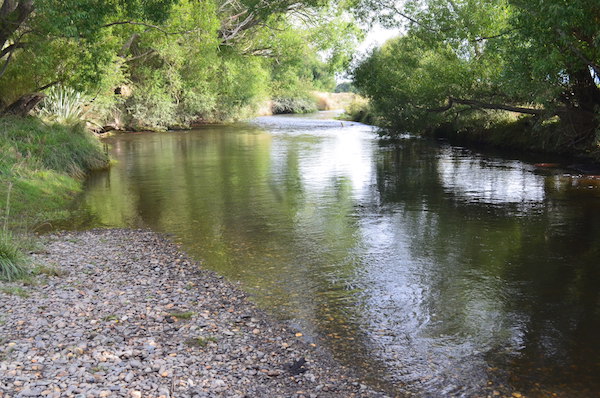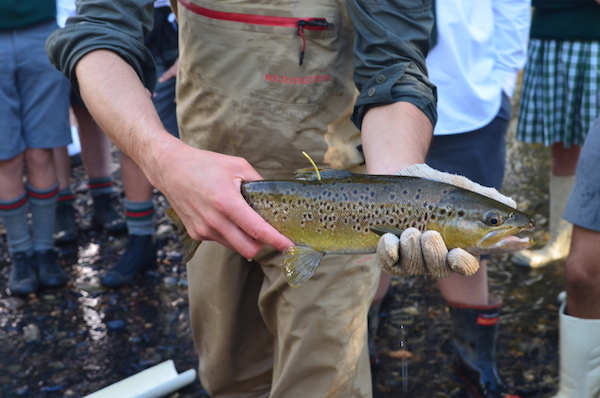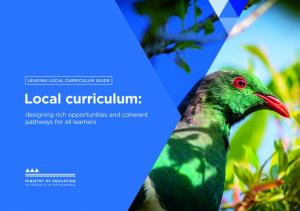Year 12 students from Menzies College have been catching and tagging trout in Mimihau Stream, sharing their findings with Fish and Game New Zealand. By gaining a more accurate picture of life in this waterway, students have challenged the assertion that Mimihau Stream is dead. This hands-on, localised project has helped students develop key competencies and has led to a much greater engagement in learning.
Getting started
The 2018 trout monitoring project at Menzies College was led by Kit Hustler, Head of Science. Kit met with field officers from the Southland branch of Fish and Game in late 2017 to discuss the possibility of monitoring fish in the Mimihau Stream. Kit was involved in similar projects when he worked as a teacher in Auckland. He finds that the practical, real-life approach engages students, especially boys.
“The New Zealand Federation of Freshwater Anglers website indicates that the Mimihau Stream is a dead waterway from a fishing perspective and we decided to see if this was the case. This learning was about finding out what the answer might be. It really engaged the boys. The genuineness of the learning – of not knowing the answer at the start – really got them going.”
The project was approved by Fish and Game on the understanding that all data would be shared with them. Students entered their findings into a shared Google Doc so that Fish and Game could access the data at any time. The school also sought project approval from the Ethics Committee.
In late February, the students met with Cohen, a field officer from Fish and Game, to learn how to set fishing nets in Mimihau Stream and process the caught trout – measuring their length and weight, and tagging them. The students then managed the nets and trout processing themselves.
New Zealand Curriculum values
As students participated in this project they were demonstrating the values of community and participation for the common good as well as ecological sustainability. Through their work they contributed to the quality and sustainability of their local natural environment.
Challenges and triumphs
Catching trout proved difficult at first and the students had to persevere and problem solve to achieve success. They kept a log book to record their methods, and each time they failed, they tried a slightly different approach.
“I knew why they weren’t catching trout but I wanted the students to work it out. I wanted them to figure out why it failed, what they might change. Some students thought they had to trial the same method at least three times before trying a new approach. Someone suggested that they put the nets across the stream. Students made stronger waratahs in their metalwork class to keep the nets fixed to the stream bed. There was continual reflecting and questioning going on. Lots of problem solving and a huge sense of teamwork.”
Kit Hustler
After two months the students finally discovered a netting method that worked and they caught and processed eight trout in one session. Spirits were lifted and a celebratory lunch of hot chips was enjoyed by everyone.
The group caught trout regularly after that and ended up tagging and releasing 35 trout at the study site. More than 35 trout were caught but some escaped during processing and others were too small to be tagged and so were only weighed and measured.
The students noticed a seasonal pattern to the fish that they caught in Mimihau Stream. Initially there were mostly eels, then trout, then lampreys and then eels and trout. They gave a presentation about their findings at a meeting organised by Environment Southland and the University of Otago in August 2018.
As well as tracking trout, the group also successfully raised salmon from eggs, with a view to using these skills to rear trout to be released into the Mimihau Stream. They released 20 young salmon into the Mataura River in September 2018.
The trout monitoring project will continue in 2019 and another initiative to monitor pollution and the population of kokopu in Wyndham Reserve is also planned.
Project impact
Students who were involved in the project were able to gain six NCEA Level 2 credits in sustainability and four NCEA Level 2 credits in digital technologies (through the digital presentation of their findings). However, the impact of the project spanned much further than NCEA credits.
One of the key benefits was the engagement of students who were previously disillusioned with school. The project helped these students become active participants in their learning, gaining a sense of ownership and responsibility.
“It was real science and not something that appeared to be contrived. It was a good way for us to show our skills – making a waratah hammer, using the computer to make signage, and a great way to gain experience by doing things and not reading about how to do them.”
Sam, student
“What I gained from this experience was getting out there more and being more engaged with the class ... I’ve learned that once you set your mind to something you can always make a change. Which was what we as a class were able to do and prove that the Mimihau is not dead.”
Kaily, student
Kit believes that the students learned important life lessons throughout the project. One of the main learning outcomes was the realisation that failure is not a bad thing and what you learn from failure is important. Students also recognised that the contributions of all team members are worth considering because a different perspective to a problem can provide the solution that others haven’t thought about.
Key competencies
The project required students to make use of and develop all five key competencies. Some of the capabilities that were practiced included solving problems, asking questions, coming up with new approaches, working as a team, and communicating ideas.
“I enjoyed working as a team and the discussions and banter around the whole process. My communication skills in dealing with a variety of people have improved and I’m able to converse with a variety of people at their level.”
Sam, student
“The real life learning was massive. Although you could say the students achieved a low number of credits, the capabilities they developed for life and learning are huge.”
Kit Hustler
The building of a closer relationship with nearby Wyndham Primary School was an unexpected, but welcome outcome of the trout monitoring project. Year 4 students from Wyndham Primary regularly visited Menzies College to learn about salmon rearing and observe the growth of the salmon from eggs until they were released. The older Year 12 students led the visits and had a chance to develop their confidence and leadership skills through tuakana-teina relationships. The primary school students stood on the banks of the Mataura River as the salmon were released and read out farewell messages to the fish.
Community engagement principle
The trout monitoring project supported the community engagement principle by connecting with students' interests and the school's local environment. The school engaged the help of their local Fish and Game office with the project and shared their findings with experts and local school children.
The Menzies College trout monitoring project has been recognised by Environment Southland who awarded the students the Environment Southland ‘Action in Environment Education’ Award in October 2018.
You might like
Leading Local Curriculum Guide Series
In order to support the progress of all students, the Leading Local Curriculum Guide series has been developed to steer your curriculum and assessment review and design decisions as you strengthen your local curriculum. It will support you to use tools to assess progress that is informative, and strengthen the partnerships you have with parents and whānau. There are three guides:
- Tags:
- community engagement
- integrated curriculum
- key competencies
- science
- secondary
- values
Return to top




